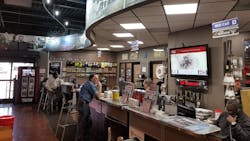Two facts about parts make them an exciting area to investigate. The first is that parts consume 40 to 70 percent of every maintenance dollar, so reducing parts cost can mean major savings.
The second is that parts can point to maintenance problems. A fleet can reduce their problems by looking at the parts used. Since most maintenance jobs require some parts, reducing parts usage will automatically reduce labor.
Choosing targets
In the maintenance storeroom, parts consumption is an important metric, but money consumption is even more so. We can use the following calculation to get a rough estimate of annual spending, by SKU, to find unnecessary waste.
For each part, multiply SKU units used per month by 12 to calculate annual usage. Multiply the resulting number by the unit cost, then add freight to calculate annual spend.
Sort this list in descending order and disregard the bottom 90 percent (if the report is 20 pages long, only keep two pages of it).
One study determined that the top 7.3 percent of the line items represented 76 percent of the yearly dollar volume spent on parts annually. Minimizing these parts’ usage provides a double bonus of saving money from the part and saving on labor.
Most fleets likely already know the top items on their parts list and already spend time on them (tires, batteries, motor oil, etc.). The next tier after these items is where it is important to focus.
For example, if a brake part costs $112.50 and a fleet uses 132 units annually, their annual purchasing cost for the part would be $14,850.
The action is to investigate the where channel (where the fleet buys it from) to either save money or reduce the annual usage, which impacts ownership costs.
Look at these items closely for potential engineering changes that could reduce usage; use preventive maintenance (PM) to reduce usage; review specifications to get better parts at the same costs or equivalent parts at lower prices (this is the situation where some level of engineering can pay off in significant returns).
By applying rigorous purchasing and negotiating techniques to lower costs, a fleet might be able to save money. This is an excellent application for the skills of the purchasing department. These items will pay dividends with creative new vendors, purchasing modes, and approaches.
Example 1
Motor oil purchased in 1-gallon bottles costs $10.00 per gallon and motor oil purchased in bulk costs $7.00 per gallon.
The cost to plumb the shop for motor oil and supply tankage is $15,500.
The fleet’s annual motor oil usage is 20,000 gallons, meaning 1-gallon bottles would cost $200,000, but buying the same amount of oil in bulk would cost $140,000.
In this case, the $15,500 cost of installing bulk oil equipment in the shop is far outweighed by the $60,000 saved annually by purchasing bulk oil instead of 1-gallon bottles. Other advantages including reduced labor, reduced contamination, higher yield, less clean-up, and less debris (bottles).
Example 2
A shipping company owned thousands of old shipping containers, and they repaired a large number each year in their shop. One of the most common repairs was the replacement of the corner posts.
They used 400 corner posts a year, and the OEM cost (as a spare part) was $396 each, for a total of $158,400 per year.
They hired a fabricating shop to reverse engineer the corner posts with particular attention to the grade of steel (muffler grade stainless) and the fit into the welding fixtures. The fabricating shop came up with a price of $199 each or $79,600 per year with a minimum purchase requirement of 100 pieces. Since there was no investment, the ROI is off the chart.
Big-ticket analysis
If a fleet needs to reduce the amount of maintenance, repair, and operation (MRO) inventory, the simplest way is to attack the big-ticket items. These are items with a value greater than $500, $1,000, or even $5,000. In later iterations of this exercise, it is possible to lower the ticket amount.
List all the items in stock with a value greater than your target. These represent most of the dollars on the shelf. Start with the costliest spare you stock and make a list in a spreadsheet like the example in Figure 1.
Note the stocking policy for each part – whether it is a capital spare or a critical spare. If it is a critical spare, skip the analysis for now.
What action can be taken to reduce the inventory level (to zero, if possible)? Consider consignment, accepting the risk of an outage, sharing parts, etc.
What engineering action can be taken to reduce the need for the part (again, to zero if possible)?
Some ways to reduce inventory levels:
- Standardize equipment
- Standardize supplies and suppliers
- Develop a spare parts interchange list
- Consider what parts can be fabricated rather than purchased
- Reduce obsolete parts
- Use only one location per part (even with different numbers)
- Reduce spoilage and shrinkage
- Control the items subject to pilferage
- Require the vendor to stock the fleet’s requirements
- Automate various functions
- Investigate stocking options
- Limit what is stored
Obsolete parts
It is not uncommon for parts to become obsolete for a fleet’s requirements. The stock room has to face the fact that parts become outdated for a variety of reasons. Some of these reasons include:
- The asset is retired
- The maintenance strategy changes (i.e. the fleet hires a vendor for full service)
- The asset is improved by engineering changes initiated by the fleet or the OEM (sometimes the OEM changes the part physically but does not change the part number, breeding confusion)
- Field reengineering to solve a particular problem
- The asset moves on to a different duty cycle, so the failures change
The process to deal with obsolete items:
- Print out a list of items with no activity for the last two years
- Cross off items that are for critical assets
- Cross off items which do not belong on the list for another reason (document the reason)
- Using the system’s data, determine where every item on the “no activity” list was used
- Highlight any parts where the asset has been retired (and there is no other asset that uses the part)
- Send the list to operations and maintenance personnel
- Have them identify items they would like to keep (document why)
- Lay out the remaining parts on the list and do a walk-through to ensure none are still needed
- The remaining parts are obsolete and can be removed
In most storerooms, about 10 percent of the parts account for 80 percent of the value. Ensuring parts are being used, inventoried, and managed properly is crucial to the fleet’s success.
Joel Levitt is the president of Springfield Resources, a management consulting firm that services a variety of clients on a wide range of maintenance issues. Levitt has trained more than 17,000 maintenance leaders from more than 3,000 organizations in 38 countries. He is also the creator of Laser-Focused Training, a flexible training program that provides specific, targeted training on your schedule, online to one to 250 people in maintenance management, asset management, and reliability.
About the Author

Joel Levitt
President, Springfield Resources
Joel Levitt has trained more than 17,000 maintenance leaders from more than 3,000 organizations in 24 countries. He is the president of Springfield Resources, a management consulting firm that services a variety of clients on a wide range of maintenance issues www.maintenancetraining.com. He is also the designer of Laser-Focused Training, a flexible training program that provides specific targeted training on your schedule, online to one to 250 people in maintenance management, asset management and reliability.
